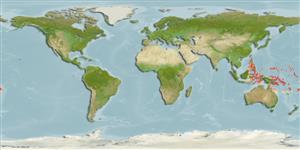Actinopterygii (peixes com raios nas barbatanas) >
Perciformes (Perch-likes) >
Lutjanidae (Snappers) > Apsilinae
Etymology: Paracaesio: Greek, para = the side of + Latin, caesium = bluish grey (Ref. 45335).
Ambiente / Clima / Intervalo
Ecologia
; marinhas demersal; intervalo de profundidade 140 - 250 m (Ref. 9821). Tropical, preferred ?; 21°N - 21°S, 117°E - 176°W (Ref. 55)
Western Central Pacific: known only from Fiji, Vanuatu, Philippines, and Tuvalu (Ref. 12596) but is probably more widespread.
Tamanho / Peso / Idade
Maturity: Lm ? range ? - ? cm
Max length : 42.0 cm SL macho/indeterminado; (Ref. 9821)
Espinhos dorsais (total): 10; Raios dorsais (total): 9-10; Espinhos anais 3; Raios anais : 8. Eye large, snout short, about equal to, or shorter than eye diameter. Interorbital space convex. Lower jaw protruding slightly. Dorsal and anal fins without scales. Pectoral fins long, reaching level of anus. Back and upper sides light brown becoming silvery white ventrally; a yellow band running diagonally from the beginning of the lateral line to the last dorsal spine.
Adults occur over rocky bottoms. Marketed fresh.
Life cycle and mating behavior
Maturidade | Reprodução | Desova | Ovos | Fecundidade | Larvas
Allen, G.R., 1985. FAO Species Catalogue. Vol. 6. Snappers of the world. An annotated and illustrated catalogue of lutjanid species known to date. FAO Fish. Synop. 125(6):208 p. Rome: FAO. (Ref. 55)
Status na Lista Vermelha da IUCN (Ref. 115185)
CITES (Ref. 94142)
Not Evaluated
Perigo para os humanos
Harmless
Uso pelos humanos
Pescarias: pouco comercial
Mais informação
Nomes comunsSinônimosMetabolismoPredadoresEcotoxicologiaReproduçãoMaturidadeDesovaFecundidadeOvosDesenvolvimento dos ovos
ReferênciasAquaculturaPerfil para aquaculturaEstirpesGenéticaFrequência alélicaHereditariedadeDoençasProcessamentoMass conversion
Ferramentas
Relatórios especiais
Baixar XML
Fontes da internet
